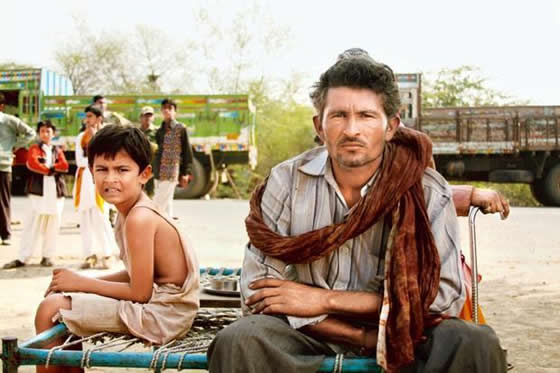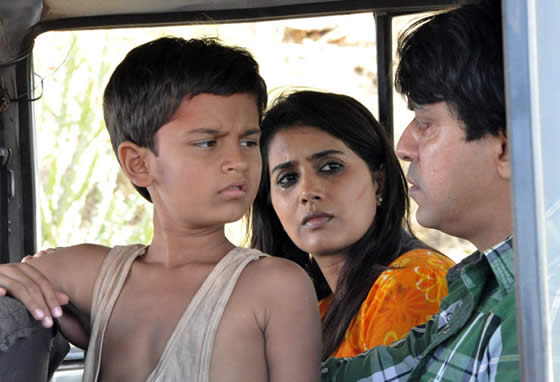 THE GOOD ROAD , directed by Gyan Arora, is India’s Oscar Entry for the Best Foreign Language Award Film. THE GOOD ROAD deals with three storylines which cross each other on the film’s titular highway.
THE GOOD ROAD , directed by Gyan Arora, is India’s Oscar Entry for the Best Foreign Language Award Film. THE GOOD ROAD deals with three storylines which cross each other on the film’s titular highway.
Pappu is a truck driver. Supporting his parents and extended family is beyond his means. Now, he has been presented a plan. An accident will be staged. Pappu will “die”. Insurance payments are substantial.David and Kiran, a middle class urban couple, with their son Aditya, are on a holiday. Aditya will be accidentally separated from them during a brief halt at a Dhaba. And his loss will only be discovered several hours, and several hundred kilometers later. They must double back to find him. Poonam is an 11-year old child from the city. She is looking for her grandmother, living in a town at the end of this highway. Tired and hungry, Poonam wisely stops at the Topaz, what seems to be a small garment dying unit.Aditya will be found by a local dhaba owner, and put onto Pappu’s truck. Has Aditya found a new and unlikely home on this truck? Later, when it is too late, Poonam will discover that the Topaz is not quite the place for her. She will be confronted, forcefully, with the very same choices she is running away from. Which way will this young girl turn? And Pappu, looking for answers to balance his need with those of this little boy, will find a new strength and conviction within.
Bija Tehranin: How did you come up with the idea of making, THE GOOD ROAD?
Gyan Arora: I am a filmmaker and I always wanted to make films, but I wanted to make films on my terms. I was just waiting to make the kind of film that I wanted to make and since I did not get scripts from anyone, I figured that I needed to make my own script because film for me is very much about expression, and about color and texture. I started to travel, looking for this, and I tried traveling on highways because that is the other thing that I have always been fascinated by, for many reasons. When I traveled on highways in India, I came across many people who had fabulous stories to tell. They were living in a world that we do not normally see and out of all of these experiences on the highway, things started forming and coming together. That is actually what inspired me and my film; the characters in the film and the texture of the film.
BT: I feel like the geography and locations in the film are characters in their own right. How did you go about portraying this?
GA: That is a wonderful question and it is a question I do not get asked very much. For me, the highway is like a system of the body—like the blood vessels. It’s what we travel on: culture travels on it, people travel on it, economy travels on it, so I definitely wanted to use the road and the world around the road in my film as a character, as you said. It is a metaphor for life and how life treats us and how we treat it. I should also say that I am a huge fan of the old filmmakers, and there are quite a few from Iran who have inspired many filmmakers today. I recently saw a film called “This is not a Film”, by Jaffa Panahi and I was so moved. It’s a film that takes place in a small little room, but at the same time there is this whole cinematic language. I feel like that kind of language is what makes cinema.
BT: I understood that you worked with a lot of amateur actors and not professionals, why did you choose to go this route?
GA: This is something that I wanted to do and I was wondering how it should be done. This was a bit of a political thing, so I have to be careful about this—not because I want to be politically correct but because I want to be accurate and what I say can be easily misconstrued. In India, the acting style is kind of very big, elaborate, colorful and very dramatic. I thought from the beginning that I wanted to make a film about people whose voices we don’t hear, about simple people—and simple as in the sense of not high-profile people, but rich in their experience, in their knowledge and in their emotional wisdom. I wanted to make that kind of person come out in my film, and when I was looking for casting, I felt that I should go with a real person as the truck driver. I also spent a lot of time with truck drivers in India and truck drivers in India are very unique. I felt that it would be easier to put a truck driver as an actor instead of an actor as a truck driver, and I wanted it to be very realistic and very naturalistic. For the little girl, I wanted the child of a prostitute, but I could not find one, so I chose a girl who comes from a similar kind of background who has never acted in a film before. These are the kinds of people that we took. I also want to say that the prevailing acting style in India does not allow for these types of films very easily, so I wanted people to get in touch with themselves and have real experiences and real expressions.
BT: Your film has many different layers, how did you balance all of the different layers in your film?
GA: It was very hard; it is a very difficult balance. At one point, you think that you have finished the film and then it’s over, but then you have to edit and the editing process can make or break your film, so this was very complicated. When I see films, I like to sit at the edge of my seat and really stare at the screen and look at every detail and understand what is happening in the frame—all the little things that you can see in the frame. I just saw Tokyo Story after many years and I saw all of the details. I would like for people to look at this film like that, because this film is like a dance. You begin really slowly and you just get drawn into it further and further, and then you enjoy it and you appreciate all of the emotional levels of the film. It was tough and I spent a lot of time editing and re-editing, but at the end I am happy that it worked out well.
 BT: How has been the reaction of the audience in India to the film?
BT: How has been the reaction of the audience in India to the film?
GA: It is a very different kind of film. I recognize now having made the film that it is quite drastic in its style and approach. It is not very modernistic, it is classical. In India, Bollywood is a huge thing and Bollywood makes my film possible: it is a huge machine and it produces a lot of talent and facilities. Many of the Bollywood technicians would give an arm-and-a-leg to work on a film like this, and I could do it only because of them, so Bollywood is good that way. In India we have to develop audiences, and that has happening, but it is going to wake a while to appreciate a non-Bollywood film. The film was made in Gujarati, which is a language of India which is not the regional language of where it was filmed. This area does not have a great cinema culture at all. Most of the cinema halls ran Bollywood films, so none of us expected it to do particularly well, but after it was selected for the Oscars, a lot of people expressed great of interest in the film, which makes me feel that the challenge is really a platform problem: having a platform to reach people. Films need to reach audiences and there needs to be a platform and I think India is great for that because films are so cheap to make here.
BT: What are the chances that your film will be nominated—or even win—the Academy Award for Best Foreign Language Film?
GA: I don’t think about that, I never have and never will. When I first started writing the script, I did not think it would even be a film because I did not think people would want to make a film like this. I originally thought of making it into a play or a book, but I am a filmmaker so I wanted to make film. I am happy that my film has been received well so far, and I can only hope for the best.
BT: What is your next project?
GA: I am working on three stories currently, but they will not be in one film because that might be too difficult.
BT: Will they be similar to what we have seen from you before?
GA: For sure, I would like to make a film which is based in tone, expression and color, and hopefully I will make it in the same process in terms of production, casting, etc.

